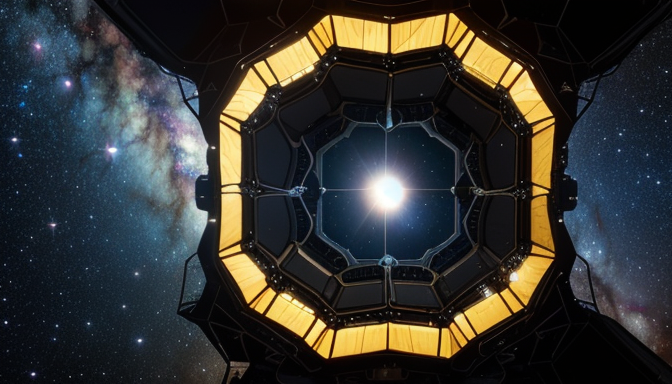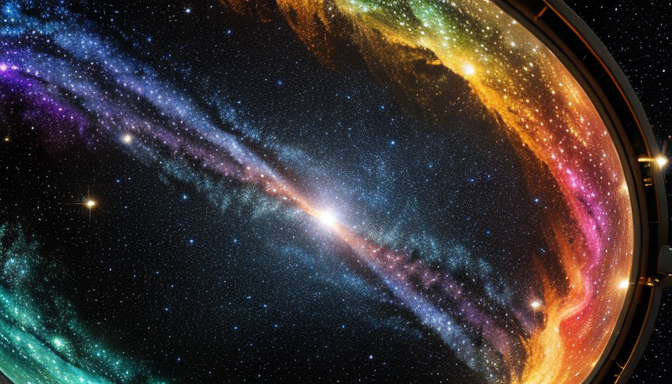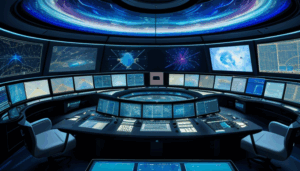The James Webb Telescope is not just another telescope; it’s a cosmic time machine that allows us to peer into the depths of the universe like never before. Imagine standing on a beach and watching the waves roll in. Each wave carries with it a story from the past, and the light captured by Webb acts much the same way. It takes us back billions of years, unveiling secrets that have been hidden in the dark corners of space.
What sets Webb apart from its predecessors is its revolutionary technology. With a mirror that’s 6.5 meters in diameter, it can collect light from the faintest objects in the universe. This capability enables scientists to observe distant galaxies, whose light has traveled across the universe for eons. As we explore these ancient celestial bodies, we’re not just looking at stars; we’re witnessing the birth and evolution of galaxies.
One of the most exciting aspects of Webb’s mission is its ability to analyze the atmospheres of exoplanets. This is like having a powerful magnifying glass that lets us see if these distant worlds could potentially harbor life. By studying the chemical composition of these atmospheres, researchers can identify the presence of elements like oxygen and methane, which are vital for life as we know it.
In essence, the James Webb Telescope is reshaping our understanding of the universe. It’s not just about collecting data; it’s about transforming our perspective on existence itself. With each new discovery, we’re not just answering questions; we’re opening up new avenues of inquiry that will inspire generations of astronomers to come. So, buckle up! The journey through the cosmos is just beginning, and Webb is leading the way.
Revolutionary Technology Behind Webb
The James Webb Telescope is not just a telescope; it’s a technological marvel that stands as a testament to human ingenuity. Unlike its predecessors, Webb is equipped with a suite of advanced instruments that allow it to peer deeper into the universe than ever before. Imagine being able to see the light from galaxies that formed billions of years ago—this is precisely what Webb enables us to do!
At the heart of this revolutionary technology is the primary mirror, which spans a staggering 6.5 meters in diameter. This large mirror is made up of 18 hexagonal segments, each crafted from beryllium and coated with a thin layer of gold to enhance its reflective properties. Why gold, you ask? Well, it optimizes infrared light capture, which is crucial for Webb’s mission. This innovative design allows Webb to collect more light, giving it the ability to observe fainter objects in the cosmos.
Webb’s instruments are another game-changer. For instance, the Near Infrared Camera (NIRCam) can capture images in infrared wavelengths, while the Near Infrared Spectrograph (NIRSpec) can analyze the composition of distant celestial bodies. These tools work in harmony to provide a comprehensive view of the universe’s secrets. Here’s a quick breakdown of some key instruments:
| Instrument | Function |
|---|---|
| NIRCam | Captures infrared images of distant galaxies |
| NIRSpec | Analyzes the chemical composition of celestial objects |
| MIRI | Observes mid-infrared light, crucial for studying star formation |
| FGS/NIRISS | Provides precise pointing and studies exoplanets |
In essence, the James Webb Telescope is transforming our approach to space exploration. Its groundbreaking technology not only enhances our observational capabilities but also opens up new avenues for discovery. So, when you gaze up at the night sky, remember that Webb is out there, unraveling the universe’s mysteries, one light year at a time!

Unveiling Cosmic Secrets
The James Webb Telescope is like a cosmic detective, using its cutting-edge technology to unravel the mysteries of the universe. Imagine peering into a vast, dark ocean where every wave holds a secret; Webb is diving deep into this ocean, illuminating things we’ve never seen before. With its powerful instruments, it’s not just looking at stars; it’s revealing the intricate processes behind their formation and the birth of entire planetary systems. This telescope is transforming our understanding of cosmic evolution in ways that were once thought impossible.
One of the most exciting aspects of Webb’s mission is its ability to analyze the chemical composition of distant exoplanets. Just think about it: we’re talking about planets that are light-years away, yet Webb can sniff out the elements that make up their atmospheres. This could be a game-changer in the search for life beyond Earth. By identifying key molecules, scientists can determine if these distant worlds might host conditions suitable for life. The implications are staggering!
Moreover, Webb is opening up a treasure trove of data that allows astronomers to piece together the history of the universe. It’s like having a time machine that takes us back billions of years to witness the birth of galaxies. With each observation, we gain insights into how these galaxies formed and evolved over time. The telescope’s findings are not just academic; they could reshape our understanding of fundamental questions about our place in the cosmos.
In summary, the James Webb Telescope is not merely a tool; it’s a revolutionary leap forward in astronomy. As it unveils cosmic secrets, it brings us closer to answering the age-old question: Are we alone in the universe? The journey of discovery has just begun, and the universe is waiting to share its stories.
Exploring Distant Galaxies
The James Webb Telescope is like a time machine, allowing us to peer back into the early universe and witness the formation of galaxies that are billions of years old. Imagine standing on a beach, watching the waves crash—each wave representing a different moment in cosmic history. With Webb, we can capture those waves, studying their patterns and understanding how they shape the universe we see today.
One of the most exciting aspects of Webb’s capabilities is its ability to observe light from galaxies that formed just a few hundred million years after the Big Bang. This is crucial because it helps scientists piece together the puzzle of galaxy formation and evolution. By analyzing this ancient light, researchers can identify key features of these galaxies, such as:
- Galaxy Shape: Are they spiral, elliptical, or irregular?
- Star Formation Rates: How quickly are new stars being born?
- Chemical Composition: What elements are present in these distant galaxies?
Through its advanced instruments, Webb not only captures stunning images but also provides data that helps astronomers understand the expansion of the cosmos. It’s like having a front-row seat to a cosmic concert, where each note played reveals a new aspect of our universe. The telescope’s infrared technology allows it to see through cosmic dust, unveiling hidden galaxies that were previously obscured from our view.
In summary, the exploration of distant galaxies by the James Webb Telescope is transforming our understanding of the universe. It’s not just about collecting data; it’s about connecting the dots in the grand tapestry of cosmic history. As we continue to analyze these distant worlds, we’re not just learning about them; we’re learning about ourselves and our place in this vast, mysterious universe.

Studying Exoplanets and Their Atmospheres
The James Webb Telescope is not just a marvel of engineering; it’s a cosmic detective, uncovering the secrets of exoplanets and their atmospheres like never before. Imagine peering into distant worlds, where the potential for life hangs in the balance. With Webb’s advanced instruments, scientists can analyze the atmospheric composition of these far-off planets, searching for the very ingredients that could support life.
What makes this telescope so special? For starters, it can detect the faint light that filters through an exoplanet’s atmosphere as it transits in front of its host star. This allows researchers to identify key molecules such as water vapor, carbon dioxide, and even methane. Each of these compounds tells a story about the planet’s environment and its potential habitability. It’s like reading the pages of a book that reveals whether a planet could be a friendly neighbor or a desolate wasteland.
To give you a clearer picture, here’s a quick breakdown of what Webb can do:
- Identify Chemical Signatures: Analyzing light spectra to find specific gases.
- Measure Temperature Variations: Understanding the climate and weather patterns on these distant worlds.
- Assess Habitability: Evaluating conditions that could support life.
As we delve deeper into the atmospheres of these exoplanets, the implications are staggering. Each discovery not only enhances our understanding of the universe but also raises the tantalizing question: are we alone in this vast cosmos? The James Webb Telescope is our gateway to answering that question, one exoplanet at a time.
Impact on Future Astronomy
The James Webb Telescope is not just a marvel of engineering; it’s a true game-changer for the field of astronomy. Its ground-breaking discoveries are poised to redefine our understanding of the universe and influence future research directions. Imagine having a powerful flashlight that illuminates the darkest corners of a vast cave; that’s what Webb does for our cosmos. With its advanced instruments, it sheds light on phenomena that were previously hidden from our view, allowing astronomers to ask new questions and explore uncharted territories.
One of the most significant impacts of Webb is its ability to delve into the early universe. By observing light from galaxies that formed billions of years ago, scientists can piece together the puzzle of how galaxies evolved over time. This insight not only enhances our understanding of cosmic history but also helps us grasp the fundamental processes that govern the formation of stars and planets. The implications are enormous, as they could lead to new theories about the origin of the universe itself.
Moreover, Webb’s exploration of exoplanets and their atmospheres is paving the way for future missions aimed at discovering life beyond our solar system. Imagine the thrill of finding a planet that could potentially harbor life! As Webb analyzes the chemical signatures in exoplanet atmospheres, it provides clues about their habitability. This not only fuels our curiosity but also inspires a new generation of scientists to explore the cosmos.
In essence, the discoveries made by the James Webb Telescope are set to create a ripple effect in the field of astronomy. They will not only influence ongoing research but also inspire future missions and technologies. As we stand on the brink of this new era, one thing is clear: the universe has many more secrets to reveal, and with Webb leading the way, we are just getting started.
Frequently Asked Questions
- What makes the James Webb Telescope different from its predecessors?
The James Webb Telescope is equipped with cutting-edge technology that allows it to observe the universe in ways that earlier telescopes simply couldn’t. With its larger mirror and advanced instruments, Webb can capture light from the most distant galaxies, offering a clearer view of cosmic phenomena and enabling groundbreaking discoveries.
- How does Webb help us understand star formation?
Webb’s powerful instruments can peer through cosmic dust clouds, revealing the intricate processes of star formation. By studying these regions in detail, scientists can gain insights into how stars and planetary systems evolve, helping us to piece together the puzzle of our universe’s history.
- Can Webb detect signs of life on exoplanets?
Absolutely! One of Webb’s remarkable capabilities is analyzing the atmospheres of exoplanets. By identifying chemical signatures, researchers can assess whether these distant worlds might have conditions suitable for life, opening up exciting possibilities for future exploration.
- What impact will Webb have on future astronomical research?
The discoveries made by the James Webb Telescope are set to revolutionize our understanding of the cosmos. Its findings will inspire new research projects and missions, encouraging scientists to explore deeper questions about the universe’s origins and its structure.

